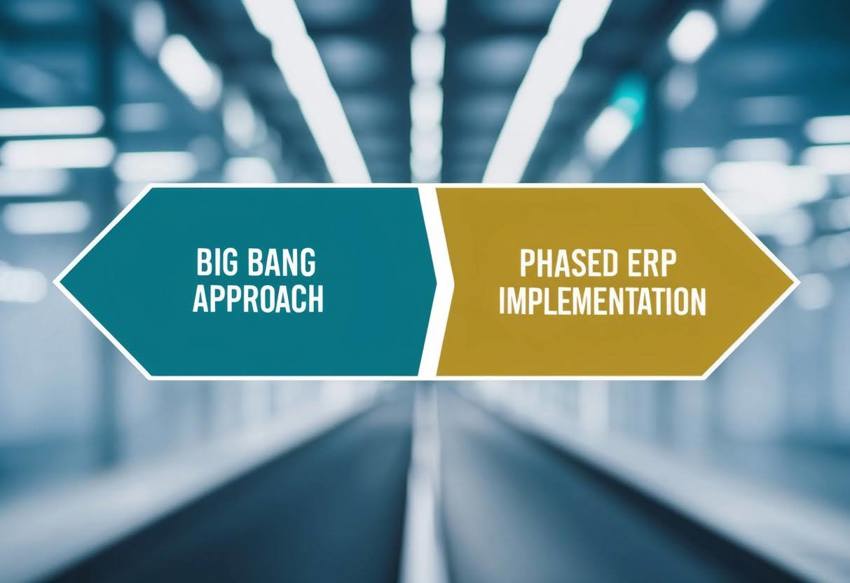Your implementation strategy can impact the success of your project. Two key approaches are the big bang and phased methods. The big bang approach involves switching all parts of your ERP system simultaneously, while the phased approach gradually rolls out the system in steps.
If your business can handle big changes quickly, the big bang approach could be suitable. However, few businesses are realistically prepared for this. On the other hand, if you prefer mitigating risk and rolling out changes gradually, the phased approach might be preferable. To understand the best method, you'll need to consider your business objectives, priorities and the capabilities of your implementation team.
Understanding both methods ensures a successful ERP implementation tailored to your needs. Collaborating with experienced implementation partners like Dynamics Consultants and aligning with your business priorities can help you choose the right path.
Key takeaways
- The big bang approach suits businesses ready for immediate, widespread change.
- A phased approach reduces risk through gradual implementation.
- Align with partners and priorities for successful ERP rollout.
The implementation challenges businesses face
We're helping businesses implement Dynamics 365 every day. And we see the same challenges occur over and over again:
- Customers are often optimistic when it comes to estimating their available time, skill sets, focus and motivation.
- During the software implementation, it’s not easy to stick to the initial plan.
- Implementation projects have the tendency to take longer than expected.
- Big bang implementations have often caused disruption and sometimes even temporarily paralysed organisations.
- Initial project principles can quickly become outdated.
Huge and long-lasting implementations with a wide and flexible project scope and complex migrations can be problematic if not handled with care and experience. Often, the problems become greater than the benefits, leading to a higher level of risk. And the possible disruption of your day-to-day operation can cause a reduction of customer loyalty. Or even worse.
Implementing new software like Dynamics 365, adapting and modernising your business processes and creating a fresh, new company culture means an enormous effort for your business. And it demands a lot from your teams. Especially because you also have a business to run. So, the alternative for a big-bang approach is to split the project into several smaller steps and have the discipline to stick to the plan.
Comparing big bang and phased ERP implementation strategies
Choosing between the big bang and phased ERP implementation strategies can affect your business operations. Each approach has its own unique benefits and potential drawbacks. You need to consider factors like project complexity, resource availability and risk tolerance to make the best decision for your company.
Big bang approach
The big bang approach involves switching your entire ERP system at a single point, offering a decisive transition for your business processes. This method provides a shorter implementation timeline as everything goes live simultaneously, reducing the drawn-out implementation period.
This strategy can lead to cost savings in terms of reduced project management and quicker realisation of business benefits. However, it carries a higher risk of failure because the testing phase may not be as comprehensive, and inadequate preparation can lead to disruptions in operational continuity. A solid effective change management strategy and detailed planning, involving all key stakeholders, can help to ensure a smooth transition.
Phased ERP implementation
The phased approach rolls out the ERP system gradually in segments over a period, allowing for a smoother, incremental approach to changing business activities. This method facilitates a gradual transition with sufficient time for parallel testing and adjustments, allowing your project team to see how it affects business processes.
One advantage of this strategy is minimising risk, as each phase can be thoroughly tested and adjusted before the next begins. This process can also reduce potential disruptions, ensuring continuous business operations.The phased approach might incur additional time and costs, as the project stretches over a longer duration, so it's important to weigh up your priorities in your ERP rollout.
Key considerations for choosing an implementation approach
When choosing your ERP implementation approach, consider your business's specific needs and operational goals. Evaluate your company’s risk tolerance and readiness for change. Assess the complexity of your business processes and the availability of resources, including personnel and budget.
Look into regulatory compliance demands and any interim period constraints that might affect your implementation process. Engage with key stakeholders to align on priorities and expectations. Ensure an effective change management strategy to support your project team and maintain momentum throughout the implementation. The choice between big bang and phased should align with your strategy for the transition and long-term operational success.
Implementing an ERP system successfully
Successfully implementing an ERP system requires careful planning and resource management. By focusing on strategic planning, managing expectations and monitoring the process, your organisation can minimise disruptions and achieve its business goals.

Strategic planning and risk management
Begin with strategic planning to align the ERP implementation with your business goals. Assess your business landscape to identify potential disruptions or roadblocks. Look at your risk level and evaluate scope creep to prevent extending beyond the agreed project scope.
Involve key stakeholders in the planning process. Their input is important for identifying potential risks and crafting a deployment approach tailored to your business needs. Use document management systems like SharePoint to maintain thorough records of the implementation cycle, helping ensure business continuity during changes.
Managing resources and expectations
Make sure you have proper resources available, such as skilled personnel and consulting expertise, to mitigate risks like inadequate training. Resource availability can impact the entire business if not handled properly.
Be clear about expectations by establishing communication strategies with business managers and departments. These strategies prevent misunderstandings and help manage expectations throughout the implementation. Align resource allocation with your business goals to optimise the efficiency of the implementation methods and reduce unnecessary consulting costs.
Monitoring and adjusting the implementation process
Keep a close eye on the implementation cycle to ensure it meets business objectives. You can introduce a parallel implementation if necessary to maintain business operations during the transition. This approach provides a safety net against potential failures.
Regularly review and adjust the implementation process based on feedback from your teams. Emphasise an effective change management strategy to address any issues promptly. Conduct an assessment of risks periodically to identify and address any concerns early on. This proactive approach allows you to adapt swiftly in response to any unforeseen challenges or additional scope that may arise.
The Dynamics Consultants verdict
Having seen the disruption and additional costs caused by so many big bang implementations, we'd always recommend a phased implementation with a series of smaller project steps. A shorter ‘time-to-value’, the possibility to adapt more quickly to changing circumstances and a smoother transition period are just a few of them.
It is no longer the right mindset to implement a perfect ERP or CRM solution that you'll then use for a relatively short period of time of around 5-10 years. It’s more effective to consider your digital transformation journey as a process rather than an entire project. A process is never finished - only improved upon as time goes on.
Frequently asked questions
Understanding ERP implementation strategies helps businesses make informed decisions. Key considerations include the advantages and disadvantages of each approach, suitable scenarios for implementation and the impact on project management.

What are the primary advantages and disadvantages of a phased ERP implementation compared to a big bang approach?
A phased ERP implementation introduces changes gradually, reducing risk and allowing adjustments as you proceed. This method can minimise disruptions in daily operations. In contrast, the big bang approach allows for a quick deployment, but is riskier.
How does the big bang approach to ERP implementation function within a business environment?
The big bang approach involves deploying the entire ERP system at once. Businesses switch to the new system at a specific point, replacing the old system. This method demands significant planning, making sure that the system is configured and tested thoroughly before go-live.
In what scenarios is a phased approach to implementing ERP systems most beneficial for a company?
A phased ERP implementation is beneficial for complex organisations with various business units or departments. This approach allows for tailored solutions and adjustments specific to each area of operation, making it ideal for large companies or those with intricate processes.
What considerations should businesses take into account when deciding between a phased approach and the big bang strategy for ERP deployment?
When deciding on ERP deployment strategies, consider the complexity of your operations, the available resources and the urgency of the implementation. Assess whether your team can handle the risk of a single deployment or prefers a gradual rollout, allowing for adjustments and learning.
What are the implications for project management when choosing the big bang approach for ERP implementation?
The Big Bang approach requires intensive project management, with detailed planning and coordination across all departments. Your team must address potential challenges swiftly, ensuring that support and training are available to handle the transition to the new system effectively.

Aimee Thompson
Before joining the Dynamics team, Aimee had worked as a Junior Content Producer. She is currently the Sales and Marketing Apprentice - aiming to achieve a level 3 qualification, BSC Principles of coding and a CIM qualification.









